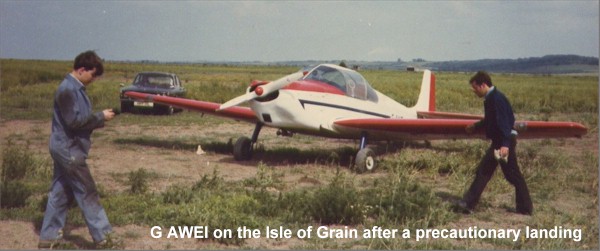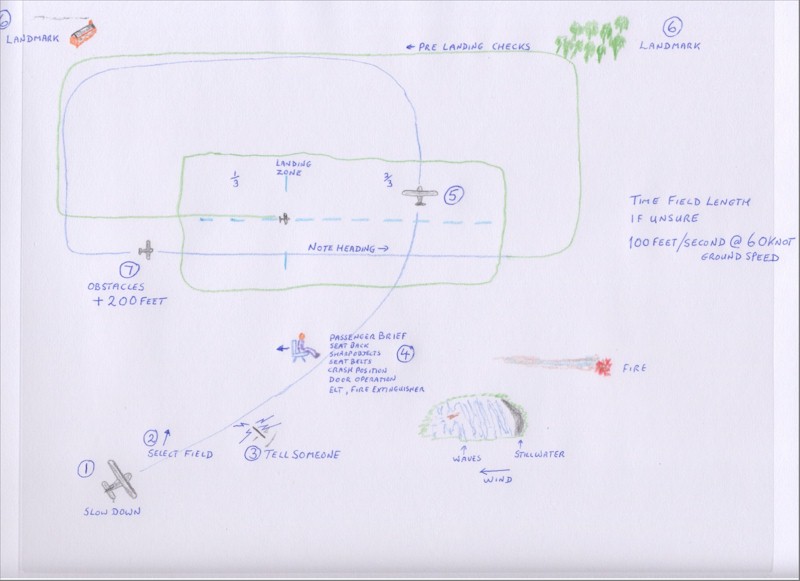
There they were...
Flying a Condor
along the canal somewhere west of Devizes, the ceilings were low
and getting lower, the rain beat on the windscreen, and the
visibility was dropping. It was a situation where being on the
ground seemed like a very good idea, and as soon as possible!
There was an excellent looking field on the right side of the
canal and so they flew low over it and inspected its surface. It
looked good, but as they climbed away to turn downwind for a
landing they saw a windsock! A quick change of mind and they
landed on a farm strip.
After parking the aeroplane, they sat down to tea and scones with
the strip's owner.... and then they phoned Michael!
This was one of several precautionary landings my aeroplanes were
involved in when I ran my flying club. It illustrates the fact
that Precautionary
Landings are a safe
option when a landing must be made as soon as possible.

Being prepared
If a pilot makes a point of looking
at the fields as he/she travels around on the ground, that pilot
will be better prepared for any precautionary landing or forced
approach situation that might happen.
When we drive a car on a route often we automatically note where
the gas stations are, in flying we need a field in mind at all
times.
Note, this procedure can also be used for landing at any airstrip where the surface condition is unknown.
Field Inspection
If we have to pick a field to land in
then we will need to inspect its surface, looking for
obstructions, ditches etc.
If it looks good then we need to determine the direction of the
wind and check the approach track, how high are the trees?
Are there any wires?
Useful things are: public telephone or local habitation.
If we land in this field would we be able to get out again?
Planning
The normal plan is to check the wind
and then fly over the field and look at it from overhead.
Turn down wind and fly a close in circuit to fly an approach to
the right of the intended approach path.
Reduce to the normal approach speed and lower the flaps as
required for better visibility, trim, and descend to 200 feet
above the highest obstacle.
You can now fly along the landing strip and check its
serviceability, and time for length.
At the end of the field climb to a reasonable height and complete
a normal circuit and a soft or short field landing as necessary.
Communication
A precautionary landing is a change
from your intended flight plan and so you will need to advise the
ATC/FSS/FIS unit you are in contact with, of your intentions.
If the place you are landing in is not an airstrip and is in a
remote place use 121.5
If you are unable to do this in the air, it is very important
that you make contact as soon as possible to avoid search and
rescue services if they are not required.
You will need to contact an FSS/ATC unit as soon as possible
after landing in any case to let them know that you are okay.
Execution
If you have a passenger you must brief that person on what you are intending to do, including moving the seat back, tightening the harness, and the crash position, if you have any doubts about the safe completion of your landing.
After landing
Contact people.
If remote: stay with the aeroplane.
Use the ELT (Emergency Locator Transmitter) if necessary.

Procedure for the Cessna 152
1. Slow down, I suggest 65KIAS@1800 RPM, with ten degrees of flap (for visibility), and trim!
2. Select a field, or your safest bet!
3. Call Flight Service/ATC/Flight Information, advise them of your position and intentions. If you are in the mountains consider 121.5.
4. Brief the passenger(s). "Don't worry I'm trained to do this and I have practiced this many times", "move your seat back, remove sharp objects from your pockets and stow them, do your harnesses up tight." "I'll ask you to open your door prior to landing, use your arm/jacket to cover your face." Review the preflight passenger briefing and emergency checklist.
5. Overfly the field and note the wind, pick a landing path, and note landmarks in the vicinity within visual range.
6. Plan your circuit with the landmarks in mind.
7. Apply twenty degrees of flap (POH), add a little
power and trim. Fly along your proposed landing path to check the
surface, check for obstructions.
.. LASSO:
Length, Approach, Slope, Surface, Obstacles. OWLS: Obstacles,
Wind, Length, Surface. Take your pick!
8. Go around...
9. If the field's good, fly a circuit, do your prelanding checks, and brief the passenger(s) again. If you can, tell someone by radio. Do a short and soft field landing with the master switch off on short final. Consider turning the magneto's off if the field is very rough.
In some books you'll be told to do the passenger brief and radio call during the last circuit prior to landing. Personally, I prefer to tell someone while I have more altitude and more radio range, and brief the passenger before I start flying low over some field!
© Michael Peare 2004